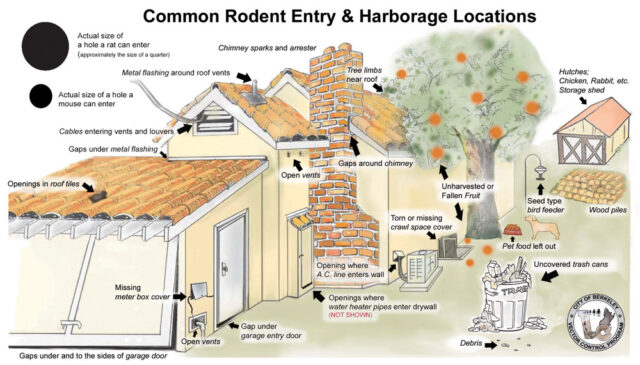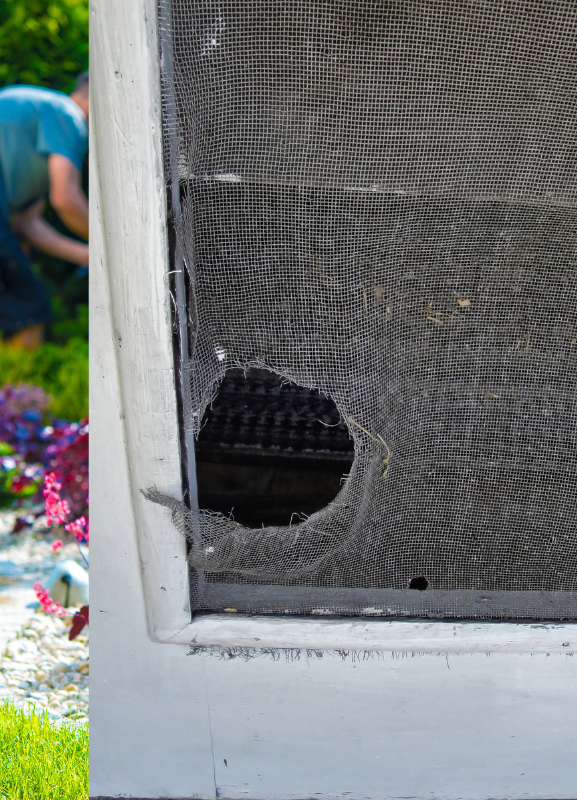Nobody likes the idea of rodents running amok in their attic or crawl space. Mice and rats can cause damage to your home structure, insulation, water heater and HVAC system. Rodent-proofing your home, apartment or business doesn’t have to be stressful. Our team or mouse and rat control specialists can put together a step-by-step plan to fully rodent proof your property.
A 5-Step Guide to Rodent Prevention
The short and sweet guide to rodent proofing is as follows:
- Remove all sources of food. Fruit trees, food crumbs, plastic snack and bread bags, pet food and drinks can all be food sources for rodents
- Survey your property for rodent problem areas. Consider basic needs like shelter, water and food
- Clear out current and future nesting places for mice and rats. Consider ducting, water heaters and behind appliances that radiate heat in winter months when rodents move inside
- Seal any potential entrances to your home. Entry points include gaps, broken or missing screens, and branches touching your roof
- Set up a rodent extermination plan to eliminate existing mice and rats and prevent them from reproducing
How to Rodent Proof Your Home
Outdoor Rodent Proofing

If you don’t already have a rat or mouse infestation, rodent proofing your house starts with the exterior. Sources of food and water can come from leaky irrigation systems, standing water, fruit trees, exposed garbage, uncovered pools, pet and bird food and home gardens.
Walk around the exterior of your home or business and look for points of entry along the foundation. Pea gravel can help with mouse or rat burrowing. Make sure all vegetation – shrubs, tree limbs, cacti are at least 2-3 feet from your homes walls. Trim the base of shrubs so that there is 1’ of space between their limbs and the ground.
If you have a garden or fruit tree in your yard, make sure you clean up any fallen fruit or vegetables. Use copper mesh along the sides and base to stop them from burrowing in. Seal your compost pile or keep it far from your home. Eliminate grubs or other insects they may eat.
Indoor Rodent Proofing
Once your exterior has been sealed, do the same with the interior. Eliminate food and water sources. The smell of spilled food in cupboards will attract mice. Keep kitchen counters clear of food overnight and clear any crumbs. Use kitchen trash cans with lids. Lastly, keep all food packages sealed and consider moving foods that come in bags into glass or sealed tupperware containers.
Rodent Habitats
Rodents like warmth in winter months so check on and around your water heater, behind appliances like refrigerators, dishwashers, and dryers.
Have a pest control expert inspect your attic and crawl space for any signs of rodent droppings near heaters.
Clear out boxes and storage clutter in basements and garages. Always store belongings on shelves or in cabinets whenever possible.
Rodent Proof Seals
 Mice can enter buildings through surprisingly tiny holes – less than the size of a dime! Have a rodent specialist inspect the exterior of your property for any gaps, cracks or crevices that mice or rats can squeeze through. Repair any broken mesh screens and clear away debris from gutters and along rooftops. Consider seals for your garage and exterior doors. Chimneys should be capped. For our attic restoration services, we use rodent-proof insulation and rodent proofing materials to make sure they are eliminated once and for all.
Mice can enter buildings through surprisingly tiny holes – less than the size of a dime! Have a rodent specialist inspect the exterior of your property for any gaps, cracks or crevices that mice or rats can squeeze through. Repair any broken mesh screens and clear away debris from gutters and along rooftops. Consider seals for your garage and exterior doors. Chimneys should be capped. For our attic restoration services, we use rodent-proof insulation and rodent proofing materials to make sure they are eliminated once and for all.
Rat Proofing vs Mouse Proofing
Mice can fit through much smaller gaps in homes so they are more likely to squeeze through openings. Rats can live for longer periods outside and have a much larger territory. A rodent control expert will help you with the nuance of Rat Proofing vs Mouse Proofing.
Rodent Proofing Companies
Pest Patrol rodent proofing services near me include the entire San Diego County area. We specialize home repairs caused by pest damage, treat rodent infestations and keep them away for the long term. Whether you live in Chula Vista, La Mesa, Escondido, or Encinitas, we have rodent proofing services on demand.

